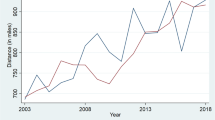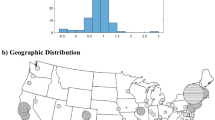Abstract
Nonlocal investors purchase and sell investment property in a distant metropolitan area. In this study, we identify capital value underperformance for nonlocal investors on both sides of the transaction, when they purchase and when they sell. The commercial real estate transactions data include a national sample of office property occurring in more than 100 U.S. markets. Using propensity-score matched sample to control for selection bias, we find that nonlocal investors overpay on the purchase by an estimated 13.8 % and sell at an estimated 7 % discount. These disadvantages relative to local investors expand with the geographic distance separating investor and asset. Nonlocal investors fundamentally overvalue similar assets sold to each other relative to assets transacted between locals, and are less patient as sellers. The positive bias in overpayment is directly tied to office rent differentials between the asset and investor markets.
Similar content being viewed by others
Notes
The number of observations used in the full sample does not include observations that are more than three observations beyond the sample mean for each of the dependent variables considered in the empirical analysis. An alternative approach to the propensity-score matching procedure uses both the trimmed and untrimmed full samples, resulting in empirical results that are qualitatively consistent in sign and significance with each of the results reported in this study.
Investor types are identified in the samples using CoStar definitions. The list of possible investor identities includes bank/finance, corporate, developer/owner – national, developer/owner – regional, educational, endowment, equity funds, government, individual, insurance, investment manager, listed funds, medical, nonprofit, other – private, other/unknown – institutional, pension fund, private REIT, public REIT, religious, REOC, sovereign wealth fund, tenants-in-common, and trust.
The list of possible sale conditions identified by CoStar includes 1031 exchange, assemblage, auction sale, bankruptcy sale, build-to-suit, building contamination issue, building in shell condition, business value added, condo conversion, court appointed sale, debt assumption, deed restriction, deferred maintenance, direct exchange, distress sale, double escrow, estate/probate sale, excess land, exercise of option, expansion, ground lease (leased fee simple), ground lease (leasehold), high vacancy property, historical site, land contract, lease option, note purchase, partial interest transfer, purchase by tenant, recapitalization, redevelopment project, REO sale, rolling option/takedown, sale leaseback, short sale, and soil contamination issue. An alternative approach is to include only transactions that occur under normal sale conditions, which does not have a material impact on the empirical results presented in this study.
For example, some variations to the model include the distance variable alone (without the nonlocal indicator and rent difference variables), the rent difference variable alone (without the nonlocal indicator and distance variables), the distance and nonlocal indicator variables together (without the rent difference variable), and the rent difference and nonlocal indicator variables together (without the distance variable).
References
Black, R. T., & Diaz, J., III. (1996). The use of information versus asking price in the real property negotiation process. Journal of Property Research, 13(4), 287–297.
Bokhari, S., & Geltner, D. (2011). Loss aversion and anchoring in commercial real estate pricing: Empirical evidence and price index implications. Real Estate Economics, 39(4), 635–670.
Clauretie, T., & Thistle, P. (2007). The effect of time-on-market and location on search costs and anchoring: The case of single-family properties. Journal of Real Estate Finance and Economics, 35(2), 181–196.
Diaz, J., III, & Wolverton, M. L. (1998). A longitudinal examination of the appraisal smoothing hypothesis. Real Estate Economics, 26(2), 349–358.
Gallimore, P., & Wolverton, M. (1997). Price-knowledge induced bias: A cross-cultural comparison. Journal of Property Valuation and Investment, 15(3), 261–273.
Genesove, D., & Mayer, C. (2001). Loss aversion and seller behavior: Evidence from the housing market. Quarterly Journal of Economics, 116(4), 1233–1260.
Hansz, J. A., & Diaz, J., III. (2001). Valuation bias in commercial appraisal: A transaction price feedback experiment. Real Estate Economics, 29(4), 553–565.
Ihlanfeldt, K., & Mayock, T. (2012). Information, search, and house prices: Revisited. Journal of Real Estate Finance and Economics, 44(1), 90–115.
Lambson, V. E., McQueen, G. R., & Slade, B. A. (2004). Do out-of-market buyers pay more for real estate? An examination of anchoring-induced bias and search costs. Real Estate Economics, 32(1), 85–126.
Liu, N., & Roberts, D. (2012). Do incomers pay more for rural housing? Environment and Planning A, 44, 1986–2005.
Miller, N. G., Sklarz, M. A., & Ordway, N. (1988). Japanese purchases, exchange rates and speculation in residential real estate markets. Journal of Real Estate Research, 3(3), 39–49.
Neo, P. H., Ong, S. E., & Tu, Y. (2008). Buyer exuberance and price premium. Urban Studies, 45(2), 331–345.
Northcraft, G. B., & Neale, M. A. (1987). Expert, amateurs, and real estate: An anchoring and- adjustment perspective on property pricing decisions. Organizational Behavior and Human Decision Processes, 39(1), 84–97.
Simonsohn, U., & Loewenstein, G. (2006). Mistake #37: The effect of previously encountered prices on current housing demand. The Economic Journal, 116(1), 175–199.
Simonson, I., & Tversky, A. (1992). Choice in context: Tradeoff contrast and extremeness aversion. Journal of Marketing Research, 29(3), 281–295.
Turnbull, G. K., & Sirmans, C. F. (1993). Information, search, and house prices. Regional Science and Urban Economics, 23(4), 545–557.
Tversky, A., & Kahneman, D. (1974). Judgment under uncertainty: Heuristics and biases. Science, New Series, 185(4157), 1124–1131.
Vrooman, D. H. (1978). An empirical analysis of determinants of land values in the Adirondack Park. American Journal of Economics and Sociology, 37(2), 165–177.
Watkins, C. (1998). Are new entrants to the residential property market informationally disadvantaged? Journal of Property Research, 15(1), 57–70.
Wiley, J. A. (2012). Buy high, sell low: Corporate investors in the office market. Real Estate Economics, 40(4), 843–860.
Author information
Authors and Affiliations
Corresponding author
Appendix
Appendix
Rights and permissions
About this article
Cite this article
Liu, Y., Gallimore, P. & Wiley, J.A. Nonlocal Office Investors: Anchored by their Markets and Impaired by their Distance. J Real Estate Finan Econ 50, 129–149 (2015). https://doi.org/10.1007/s11146-013-9446-8
Published:
Issue Date:
DOI: https://doi.org/10.1007/s11146-013-9446-8




